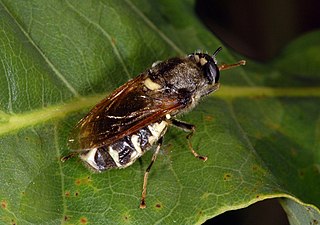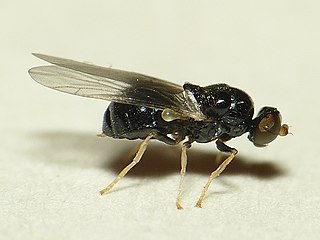
The soldier flies are a family of flies. The family contains over 2,700 species in over 380 extant genera worldwide. Larvae are found in a wide array of locations, mostly in wetlands, damp places in soil, sod, under bark, in animal excrement, and in decaying organic matter. Adults are found near larval habitats. They are diverse in size and shape, though they commonly are partly or wholly metallic green, or somewhat wasplike mimics, marked with black and yellow or green and sometimes metallic. They are often rather inactive flies which typically rest with their wings placed one above the other over the abdomen.

Actina chalybea is a species of 'soldier flies' belonging to the family Stratiomyidae subfamily Beridinae.

Chloromyia formosa is a species of soldier flies belonging to the family Stratiomyidae. Another name for it is Broad centurion.

Stratiomys singularia, the flecked general, is a Palearcticspecies of soldier fly.

Sargus flavipes, the yellow-legged centurion, is a European species of soldier fly.

Sargus cuprarius, the clouded centurion, is a European species of soldier fly.

Pachygaster is a genus of flies in the family Stratiomyidae.

Pachygaster atra, the dark-winged black, is a European species of soldier fly.

Neopachygaster is a genus of flies in the family Stratiomyidae.

Oxycerini is a tribe of flies in the family Stratiomyidae.
Oxycera analis, the dark-winged soldier, is a species of soldier fly.

Oxycera pygmaea, the pygmy soldier, is a European species of soldier fly.

Oxycera morrisii, the white-barred soldier, is a European species of soldier fly.

Oxycera leonina, the twin-spotted major, is a European species of soldier fly.

Nemotelus uliginosus, the barred snout, is a Palearctic species of soldier fly.

Chorisops nagatomii, the bright four-spined legionnaire, is a European species of soldier fly.

Chorisops is a genus of flies in the family Stratiomyidae.

Beris vallata, the orange legionnaire or common orange legionnaire, is a European species of soldier fly.

Beris is a genus of flies in the family Stratiomyidae. They are also referred to as the false soldier fly. As described by Latreille in 1802, these are small to medium sized flies with metallic colors.
Beris strobli is a European species of soldier fly.















